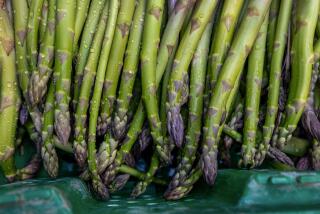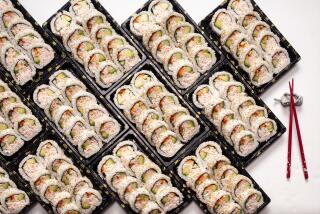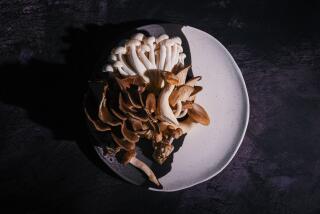Only One of Its Kind in U.S. : California Snail Rancher Turns Slippery Mollusk Into High-Flown Escargot
- Share via
PETALUMA, Calif. — As ranchers go, Tracy Brash and Michael Beyries count among the country’s smallest--and largest. Their feedlot, where livestock is fattened, is compact enough to fit comfortably within a 25-acre dairy farm.
Squeezed into that space, however, are about 750,000 head on the hoof.
Indeed, this livestock appears to be nothing but head and hoof. Brash and Beyries are snail ranchers.
Their operation, including the snail equivalent of grazing lands near San Diego and Ojai, is currently the only federally permitted, commercial snail--er, escargot-- rancher-canner in the United States.
The company--named Enfant Riant, or “laughing child”--is run out of a small industrial park in the north end of this Sonoma County town.
“I like to tell people I have ‘this little spread’--with 7 million head,” said Brash, 36, who during the peak season in summer does indeed count millions of snails among his assets.
But these are not just any snails. Brash trades only in the finest escargot that a hungry ranch hand can sink his petite fourchette (little fork) into.
“What is imported into this country is garbage,” he sniffed. Most of the snails here, he said, are really chopped up bits of the softball-sized giant African snail, or achatine-- 85% of which originates in Taiwan, even if it is packaged and eventually imported from France.
“The achatine served as escargot in this country could not be served as escargot in Europe,” he said. “It is served as what it is--achatine, ‘poor man’s escargot.’ ”
The result, he said, is that most Americans willing to sample escargot wind up with “garlic, butter and this chewy little something.”
This perplexed and disappointed him when he returned to California after spending four years as a building contractor in Europe, where he acquired a taste for escargot. Particularly odd, he thought, was that Americans ate achatine when the creme de l’escargot, the Helix Asperia variety, was probably slithering through their gardens.
The Helix Asperia is not native to California. It was imported by Italian and French immigrants after the California Gold Rush of 1849 as a food staple. It prospered in its new home and is now most often thought of as a garden pest.
“We have the best in the world out in our backyards,” Brash said with a look of genuine amazement, “and all we were doing was going, ‘Ewww!’ ”
Brash instead said, “Hmmmmm . . .” and decided to raise a few for his own consumption.
It was not as easy as it sounds. Snails tend to assume the flavor of their last meal, Brash noted, so he had to fatten them up on bran and soy meal, then starve them for several days to purge them of what he delicately referred to as “grit.”
The result, however, was worth the work. He had his own thrifty supply of top-of-the-line escargot, the delicate petit gris variety savored by the French. They were even good enough, he said, to favorably impress an old friend, the chef of a fancy New York restaurant. The chef, on learning of the source of the delicacy, ordered 50 dozen on the spot, Brash said, and the idea for Enfant Riant was born. Beyries, 37, a lifelong friend of Brash’s and part-time professor and stand-up comedian, soon came into the business as a partner.
Before they are canned in water and sent to gourmet stores and restaurants in 47 states, Enfant Riant’s escargot start as snails grown on working Southern California farms where other crops are raised. As with most details of his operation, Brash is reluctant to say exactly what kind of fields they are, except to say they are owned by someone else.
“People call us all the time asking how we raise our snails--like we are supposed to just give away all our secrets,” he said, shaking his head. Brash said he invested $500,000 working out his present system.
After five weeks growing to size in the field, the snails are packed off to Petaluma for another five weeks at the feed lot, supping bran and soy.
Then it’s off to the processing plant, where lowly snails assume the mantle of escargot.
Each month, four tons of escargot are washed, steamed, shelled, then washed again, in vinegar and water--”to cut the slime, although we like (the term) ‘slipperiness’ better,” Brash said--before being canned.
Learning to can them took 11 months of hit-and-miss experimentation before Enfant Riant found a method that was sanitary without cooking the escargot to mush.
Even with that, the hardest part is not manufacturing, but marketing. Brash said he traveled more than 50,000 miles last year trying to win new fans for a mollusk that still turns more stomachs than it lands in.
“We are like the wine industry was 25 years ago,” he said. “The attitude is, ‘Only the French can do it (prepare snails) well, and only the rich enjoy (consuming) it.’ We’ve got to overcome that.”
To that end, each can of 36 escargot--which cost $7 to $9 each--comes with five recipes that encourage consumers to take them out of their traditional garlic-and-butter sauce and try them as a deep-fried snack, for example, or tossed with pasta.
“The Asperia has a taste like a wild mushroom,” he said enthusiastically. “It’s wonderful.”
They also have virtually no cholesterol, few calories and are 16% protein, he added.
Such talk seems to be working. Brash said sales nearly quadrupled in January compared to the same month a year ago, although he declined to give specific sales figures.
He did, however, say that his product can be found in such diverse locations as Chez Panisse, the fashionable Berkeley restaurant (which receives its escargot from Enfant Riant live, not canned) and soon in Longs Drug outlets in the San Francisco Bay area. About 60% of his product is sold in stores; the remainder is shipped to restaurants.
Despite such occasional flights of enthusiasm for the product and the profusion of snail-shaped doorstops, tape dispensers and other knickknacks around the office, Brash is equally enthusiastic about some of the buyout queries the company has started to receive.
“I’m in this business because it is a business,” he said. “It’s not as if snailin’ is my life.”
More to Read
Sign up for Essential California
The most important California stories and recommendations in your inbox every morning.
You may occasionally receive promotional content from the Los Angeles Times.










